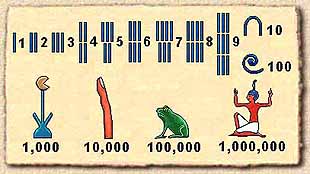
The ancient Egyptians established settlements in the fertile Nile valley as early as around 6000 BCE. They embarked on the recording of lunar phases and seasonal patterns, motivated by both agricultural and religious considerations.
In the early days of Egyptian civilization, the Pharaoh’s surveyors employed measurements derived from body parts, using units like the palm (equivalent to the width of a hand) and the cubit (the distance from elbow to fingertips) to gauge land and construct buildings. Additionally, they developed a decimal numeric system based on the ten fingers. The oldest known mathematical text from ancient Egypt, known as the Moscow Papyrus, dates back to the Egyptian Middle Kingdom, approximately from 2000 to 1800 BCE.
Ancient Egyptian Number System
It is believed that the Egyptians introduced a fully-developed base 10 numeration system, possibly as early as 2700 BCE, and potentially even earlier. In their written numerical notation, they used various symbols: a stroke represented units, a heel-bone symbol signified tens, a coil of rope represented hundreds, and a lotus plant represented thousands. They also employed hieroglyphic symbols for higher powers of ten, extending up to a million. However, they lacked the concept of place value, making larger numbers cumbersome to express. For instance, writing a million required just one character, while representing a million minus one necessitated fifty-four characters.
The Rhind Papyrus, dating from around 1650 BCE, serves as an instructional manual covering arithmetic and geometry. It provides explicit demonstrations of multiplication and division methods employed at that time. The document also contains evidence of various mathematical knowledge, including unit fractions, composite and prime numbers, arithmetic, geometric and harmonic means, as well as methods for solving first-order linear equations and arithmetic and geometric series. Another ancient text, the Berlin Papyrus from around 1300 BCE, demonstrates that the ancient Egyptians could solve second-order algebraic (quadratic) equations.
For multiplication, they used a process of repeated doubling of one number while simultaneously halving the other, resembling a multiplication of binary factors, similar to techniques used by modern computers. This method utilized corresponding blocks of counters as a multiplication reference table, isolating the combination of powers of two that added up to the number being multiplied, with the corresponding blocks on the other side yielding the answer. This early use of binary numbers predates its introduction to the Western world by Leibniz by over 3,000 years, and long before computers fully explored its potential.
The need for practical solutions in trade and markets led to the development of fraction notations. Surviving papyri demonstrate the use of unit fractions based on the symbol of the Eye of Horus, where each part of the eye represented a different fraction, halving the previous one (e.g., half, quarter, eighth, sixteenth, thirty-second, sixty-fourth). This represented the first known example of a geometric series.
Unit fractions also facilitated simple division problems. For instance, to divide 3 loaves among 5 people, they would divide two of the loaves into thirds and the third loaf into fifths, resulting in each person receiving one-third plus one-fifth plus one-fifteenth, totaling three-fifths.
The Egyptians approximated the area of a circle by using shapes with known areas. They noticed that the area of a circle with a diameter of 9 units closely matched the area of a square with sides of 8 units. This led them to the method of multiplying the diameter by 8⁄9 and then squaring it to approximate the area of circles with various diameters, providing an effective approximation of π accurate to within less than one percent.
The construction of the pyramids underscores the sophistication of Egyptian mathematics. Although debates exist about the presence of the golden ratio in the pyramids for purely aesthetic reasons, there is clear evidence that they understood the volume formula for a pyramid (1⁄3 times the height times the length times the width) and for a truncated or clipped pyramid.
Furthermore, the Egyptians were aware of the Pythagorean theorem long before Pythagoras. They used knotted ropes at intervals of 3, 4, and 5 units to ensure precise right angles in their stonework. In fact, the 3-4-5 right triangle is often referred to as the “Egyptian triangle.”


